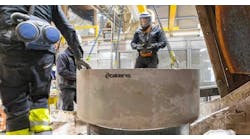Tisamatic, a metalcasting subsidiary of the Grupo Industrial Saltillo (GIS) conglomerate, opened a second foundry in San Luis Potosi, Mexico, late last month, a project reported to have cost $65 million. The new plant adds 220 new jobs there, and doubles total capacity at the site to 120,000 metric tons/year.
With Tisamatic and another subsidiary, Cifunsa, GIS now has total metalcasting capacity of 240,000 metric tons/year. Its high-precision gray and ductile iron automotive castings include engine blocks and parts for drivetrains, brakes, and chassis systems.
The new plant is particularly focused on exporting castings to automakers in North and South America, and eventually Europe and Asia as well. Over 90% of the output will be exported, according to Tisamatic.
According to GIS chief executive José Manuel Arana, "This new facility has several critical points that differentiate us,” describing quality control functions for moldmaking, metal pouring, and controlled cooling of cast parts.
Alfonso Gonzalez Migoya, president of the board of directors of GIS, noted in his remarks at the plant’s ribbon-cutting event that Mexico is undergoing the changes necessary to compete in the global economy, and he compared such efforts to the country’s recent constitutional revisions.
"We hope that our legislators successfully completed with the conclusion of the so-called secondary laws to endow the country with a legal framework in line with the demands of today's world, (and) we rely on their vision and their zeal to establish greater welfare for all Mexicans.”









